Bradstreet and the Creative Child [Poetry Analysis]
@mrslauren was on @msp-waves radio last night discussing her current experiences at college, and how she was using some of her notes and classwork as inspiration for steemit posts. I thought this was an excellent idea- what a great way to add value to the platform! Educational pieces and materials for free, benefiting both the community and author. I have a Bachelors in English Education and a Masters in Education Administration, and plan to post the papers and various reflections that I wrote for my classes in receiving those degrees. I will edit the papers to make them a little more readable, and add images as well as links where applicable.
The first paper I picked was written for my American Literature class during my bachelors. In it, I analyze “Before the Birth of One of Her Children” by Anne Bradstreet. This paper would be useful for poets to read, as it would help them understand how metaphor and ambiguity works in a poem. Reading analysis of poetry helps us become better poets! Also, I picked this piece because Anne Bradstreet was a subversive badass- she was a Puritan woman, writing during an age and culture where women were expected to stay home and raise the children. They were not allowed to participate in academic or creative culture, and in fact, her poems had to be prefaced by a man in order to be accepted. She's a bit of a feminist icon among poets, so I'm excited to feature her first in my educational series.
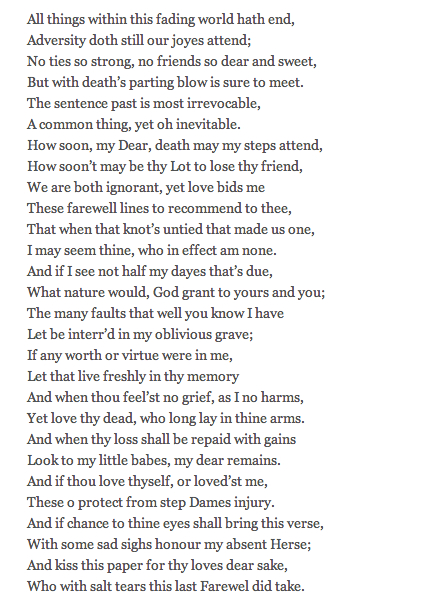
Image Source
Bradstreet and the Creative Child
One of aspects of poetry that makes it beautiful is ambiguity. Through ambiguity, the poem then expresses a universal emotion that appeals to readers across time. Anne Bradstreet’s poetry, however, is different. Her poem, “Before the Birth of One of Her Children” is, at first glance, obviously interpreted as being about the speaker’s biological children. While this is one possible interpretation, a more complex and compelling interpretation is that Bradstreet is reflecting on the creative process and creative product through metaphor. This poem is not concerned with the speaker’s wishes for her biological children, but for the metaphorical “life” of Bradstreet’s writing after her death.
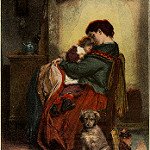
Source
The speaker acknowledges consistently throughout the poem that she will die. This is especially emphasized in the first line, which mentions, “All things within this fading world hath end” (Bradstreet 1). Bradstreet also uses imagery of impending death throughout the poem, such as “death’s parting blow”, “death may my steps attend”, “oblivion’s grave”, “love thy dead”, “my dear remains”, and “my absent hearse” (Bradstreet 4, 7, 16, 22, 26). All of these images not only create a sense that the author is dead, but that the author will be “absent”. This is unusual is Puritan poetry, which tends to emphasize life after death and heaven for the elect. Although Puritan’s believed that a husband and wife did not remain married in heaven, the poem appeals to the reader/addressee to mourn the speaker after death. Puritan society also frowns upon excessive grief for loved ones, but Bradstreet has written many eulogies for famous and familial dead. The death imagery puts the poem squarely in the earthly realm, not the spiritual, and paints herself a more subversive poet than the preface written by John Woodbridge would have the reader believe.
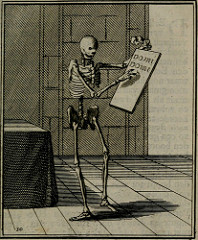
Source
If the poem addressed a physical person, either an adult or a child, the speaker would surely show concern for that person’s spiritual or emotional well-being. The lack of mention of any spiritual wishes for the person is evidence that the poem is about a creative product, which lacks a soul. There is also a lack of mention of the addressee’s death, also pointing to that person being a metaphor for a creative product rather than a real person. The speaker mentions that “thou feelst no grief as I no harms” (Bradstreet 19) comparing the metaphorical addressee’s lack of emotions to the speakers lack of harm after death. This points to the author referring to an inanimate object, rather than an actual person. This is an example of personification turned on its head, where the object is defined by what human qualities it does not possess, rather than what it might as given by the author. This device is effective in making the poem more ambivalent by changing the way that the “child/husband” that the poem is directed at can be interpreted.
The speaker of the poem does not ask for any spiritual guidance for the addressee, but does ask for God’s blessing. The speaker says, “And if I see not half my days that’s due,” again acknowledging that she will die, but then adds “God grant to yours and you” (Bradstreet 13-14). This is similar to other authors who have wished for immortality for their poems. “Yours and you” refers to the current poem as well as the rest of Bradstreet’s work (Bradstreet 14). The universality of authors wishing for a “life” for their poem beyond their own dates back to Shakespeare and Chaucer. Bradstreet, who did not publish her own poems, may not have originally expected any acclaim or fame for her poetry. However, as this poem was written later in her career, it is entirely possible that Bradstreet’s expectations for her poems had changed, and that is reflected in her poetry.
No author, however, expects that poem’s life to be the same one they originally expected. Like a wayward child, a poem has a habit of separating itself from the author. This is illustrated when Bradstreet writes, “I may seem thine, who in effect am none” (Bradstreet 12). The author uses the word “seem” to denote that although the author’s name is on the work, their intentions once the work is published are “none” in comparison to that of the reader's interpretation. This is also emphasized by Bradstreet’s line, “That when that knot’s untied that made us one” (Bradstreet 11). The knot can be interpreted as an umbilical cord, or the knot of marriage, but more convincingly it appears to be a metaphor for the act of creation. The thought process required to untie a complicated knot is also related to the thought process required to write great poetry. Also, the knot “made us one”, or unites the author and poem together within the author’s mind. To continue the metaphor, if the knot is the thought process of writing, then once the act of writing is complete, the knot is “untied”, and then the poem is no longer one with the author. The separation of author and creative product serves both as boon for the author, allowing them the freedom to write in any voice they choose, and curse, as the author loses control over the interpretation of their work.
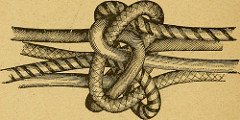
Source
The author’s love for the poem is also compared to a mother’s love for her child. The speaker calls the addressee of the poem “my dear remains” and hopes that “These O protect from step-dame’s injury” (Bradstreet 22, 24). To continue the metaphor of a poem child, then the step-dame could be compared to the critics who would later attack and possibly misinterpret Bradstreet’s work. This is also a fear of author’s everywhere. Many authors are concerned that once the poem is separated from them, that someone can take the poem and butcher it beyond the author’s intent. This leads author’s to write critiques and appendixes in order to clarify their work, but much of the beauty of poetry is lost. Post writing occurs when the author fears the reader’s freedom of interpretation. By including the wish for protection from “step-dame’s injury” within her poem, Bradstreet renders the need for clarification nil. The wish to protect a poem is enough to make any analysis careful and complete, while still allowing for an open interpretation. It is important that the author does not make “excuses” for her work, just as one should not try to justify a child’s bad behavior.
The speaker also criticizes herself and the poem/child/addressee. She writes that “We both are ignorant”, continuing the idea that she is referring to the poem, an inanimate object (Bradstreet 9). Words on a page are ignorant as a matter of course, just as any inanimate object is, due to the lack of consciousness. Both speaker and poem are also ignorant of the future, including the speaker’s foreshadowed death. This is significant in that the author expects the poem to live on, but will continue to be ignorant. According to Bethany Reid in her essay, “Unfit for life: Anne Bradstreet’s Monstrous Birth”, Bradstreet presents her work, “…as a child, malformed, heretofore sheltered, but already walking and talking, capable of being imperfectly schooled by its mother” (Reid 539). The speaker does not expect perfection from her poem, but merely hopes that it will have a better “life” than her own.
The speaker not only acknowledges her death, but her flaws in life as well. The speaker requests that “If any worth or virtue were in me/ Let that live freshly in thy memory” (Bradstreet 17-18). The poem of course, does not have memory, however, its reader does. The speaker is essentially requesting that the reader only remember the good in her work, and forget the bad. In the metaphor, this would relate to a mother’s wish for their child, but it also speaks to what an author wishes for their reader.
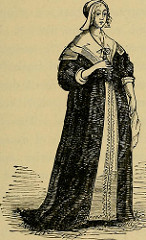
Source
Bradstreet published her work in a time when minority writers required a male, white man to create a foreword in order to establish their plausibility with readers. This dependence on the powerful majority leads minority writers to create new ways to make the importance of their work more evident within their writing. By comparing the creative process to the act of childbirth, Bradstreet automatically does not include men. This reverses the common roles of Puritan society, where women were excluded from writing. Reid concurs in her essay, “Unfit for life: Anne Bradstreet’s Monstrous Birth”, that “Motherhood was legitimizing for a woman; poetry, on the other hand, was not” (523). The fact that the author takes a legitimate activity as a metaphor for an illegitimate one is significant in that it transforms the act of writing for women and reveals the author’s subversive opinion that it should be a legitimate activity.
Just as children take on a separate life from their parents, so does Bradstreet’s poetry, which can be interpreted in any way the reader so chooses. To merely interpret Bradstreet’s poem as being simply about childbirth does a disservice to a complex poet. Bradstreet was a writer in a field dominated by men; by comparing the act of creating a poem to the act of creating a child, she creates a new metaphor that allows women a voice in the New World.
Works Cited
Bradstreet, Anne. “Before the Birth of One of Her Children”. The Heath Anthology of
American Literature. Volume 1, Fifth Edition. p. 406.
Reid, Bethany. "Unfit for Light": Anne Bradstreet's Monstrous Birth. The New England
Quarterly. Vol. 17, No. 4 (Dec., 1998) p. 517-542.

Initial reflection and "Anne Bradstreet and the Creative Child" are property of sunravelme
You had me at Anne Bradstreet was a subversive badass.... and then you lost me--- but that isn't your fault, that's most definitely the fault of the incredibly good beer my brother bought me yesterday that I am now, um, drinking ;)
Okay, seriously though, I will return to this page.
I forgive you- but just because the beer was incredibly good ;) Thank you for checking it out!
Awesome to see the world of academia make it's way over to my favorite platform! So many great ideas, so little time <3
Yes, the lack of time is definitely problematic, but steemit makes me want to make more of it!
This is what is meant by quality post. What a nice Poem indeed. So touching to them that can decode it's content and deceptive to them that wouldn't read beyond the poem itself.
Thank you! While I certainly prefer modern poetry, there are things to be learned from poets in the past, for sure.
wow, that is a beautiful composition, nice job.
Thank you!
Wow intense!